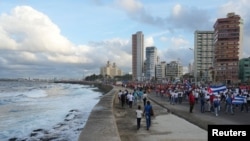In the South American country, the mosquito-borne disease has caused more deaths over the past four months than in any other year. The explanations behind this dramatic rise are multiple, and range from the weather to the usual deficiency and lack of state forecasting.
The dengue epidemic in Peru has reached figures never before recorded. So far this year alone, infections have risen to 172,500 and deaths are already close to 300.
Most of the human losses are concentrated in Piura, a hot region on the north coast of the country, where cases of infection from mosquito bites Aedes aegypti there are more than 50 thousand; that is, close to a third of those reported throughout the national territory.
The latest weather events in the country, the failures in the sewage systems, limited access to drinking water, and the fragility of the state health services were a perfect mix for the disaster to materialize. Specialists and officials consulted by France 24 warn that the South American nation has lived – already in the post-coronavirus pandemic – another catastrophe that once again tested its health capacity amid structural deficiencies. Additionally, the possibility of El Niño Costero and El Niño Global phenomena for the following months leads us to assume worse scenarios for 2024.
An unusual rise in just five months
According to the history of figures from the National Center for Epidemiology, Prevention and Disease Control (CDC), belonging to the Peruvian Ministry of Health, deaths from the disease had not exceeded 89 in previous years. In fact, in 2018 and 2019, infections and deaths remained much lower. Only in 2017, when Peru experienced its worst Coastal Child phenomenon in decades, dengue rebounded in just under 68,300 cases of infection. Now, the cases threaten to triple.
The drama that Peru is experiencing with dengue is even greater than that of some other countries where the disease has also spread. In compared numbers Until the beginning of June, the Peruvian territory reached 6.49 deaths per million inhabitants, a mortality rate that exceeds those of Bolivia, Brazil, Argentina, Paraguay and Colombia.
“Climate change has a lot to do with it. [con este fuerte brote del dengue en Perú]. In Peru, particularly, the Yaku cyclone hit, which brought us very heavy rains in March. These two conditions – increased temperatures and heavy flooding – were key to the reproduction and proliferation of dengue disease vectors; that is, of the mosquitoes that transmit it to the population. But another no less important factor is the structural problem, with terrible drainage and sewage systems. The accumulations of water only generated a more conducive nest for mosquitoes. And now, the classic Peruvian problem: bad or deficient health services, which were saturated by an atrocious number of infected people ”detailed Juan Celis Salinaspresident of the Peruvian Society of Infectious and Tropical Diseases (SPEIT).
Intense and prolonged fever, followed by vomiting, nosebleeds, other hemorrhages, and shocks facilitated by comorbidities is the usual line of symptoms in victims at risk. Of the total number of people who died in 2023, about 30% did not resist the infection after just one or two days of going to hospitals. According to the CDC, this was also due to the fact that those infected –due to the distance between their homes and health centers or due to carelessness in the face of the first signs of alarm– did not arrive in time to counter fatal outcomes.
The groups most at risk from the virus
The regions of Piura, Lima, Ica, Lambayeque, Loreto, Ucayali and La Libertad were, at the beginning of June, the ones with the most infections in the entire country. But the degree of vulnerability to the virus is not the same for all people. Living in precariousness, without access to basic services or permanent drinking water networks, is the precondition detected in a vast majority of people who have suffered or are suffering from the disease. This, added to other factors, such as age (infants and infants and older adults), the state of pregnancy and pre-existing or chronic diseases, usually increase the severity of symptoms.
“The areas where there are the greatest number of people infected by dengue are those where some conditioning issues of health are lacking. The most important: water. These people, not having access like others do, are forced to collect drinking water in containers, which creates the perfect environment for mosquitoes. We can say that the most affected places are those that do not have social determinants to guarantee comprehensive care during this emergency,” he said. Liliana Bobadilla Bocanegracommissioner of the Deputy for the State Administration of the Ombudsman of Peru, to France 24.

One of the strategies of the Ministry of Health (Minsa) as an attempt to control and reduce vector mosquitoes is fumigation in homes. However, in regions where the spread of the virus has been high, the state response has not been the most appropriate. The week before, the Lambayeque regional health management reported that the sector had sent 130 spraying machines, but that 94 of them arrived inoperative.
On a recent visit to the region, Minister César Vásquez Sánchez was consulted by the press regarding this incident: “They are being used elsewhere [las fumigadoras] and sometimes a bulb or spark plug burns out. These things happen. These teams will be put into operation this week,” said Vásquez, who has been the head of Minsa since just June 19.
The deficient management of the Minsa with respect to the dengue epidemic has been notorious since the beginning of the alerts. By the beginning of April, SPEIT, chaired by the infectious disease doctor Juan Celis, had sent a report to the ministry to warn of an unusual shot in cases that were being treated in regions.
“We suggest [al Minsa] a national diagnosis on the situation and actions for early detection and the habilitation of hospital beds. This in the middle of the Yaku cyclone, which could already make us assume a fairly strong epidemic. Unfortunately, the response came a month later, asking us to certify where the virus is concentrating, as if we had the data that the Minsa has. We only report because we are doctors who are seeing the cases in some regions. Finally, an epidemic developed that we can now say is the largest in the history of dengue in Peru.”Celis explained.
Criticism of the response of the Health sector and pending actions
This medium contacted César Munayco Escate, director of the National Center for Epidemiology, Prevention and Disease Control (CDC) of the Peruvian Ministry of Health. Munayco acknowledged that, to this point, the management of the epidemic has had some errors. However, he pointed out that action has been taken to counteract deficiencies such as sanitary capacity.
“In general, there are a significant number of people who require close monitoring. Several clinical monitoring units have been opened, the offer in hospitals has been expanded, beds have been increased, and tents have been set up to care for the population. But the most important thing is to carry out a good triage to determine which cases require hospital care and which regions require patient transfers to less saturated health facilities. That has not been stopped,” said the official.
By mid-June, the then Minister of Health of Peru, Rosa Gutiérrez Palomino, resigned after being invited by Congress to explain the actions against the epidemic. Gutiérrez spent a little less than 200 days as head of the sector, and her brief tenure was the target of criticism due to the political manipulations and technical decisions that were made on the emergency. In May, the now former official had publicly offered that the virus would be eradicated within two weeks. However, in those 15 days, the outbreak intensified and reached its maximum peak of victims.

Liliana Bobadilla, from the Ombudsman’s Office, indicated that there is a great responsibility of the Minsa for the overflow of dengue cases. He explained that, even knowing that there is a gap of 10,000 doctors and specialized personnel in the country, the sector ordered late, on May 25, the double perception or double shift of doctors to face the collapse of hospitals.
“There has been a lack of opportunity in the transfer of resources, in technical assistance from the ministry and in the provision of a greater number of hospital beds. This should have been foreseen since March. There was no adequate action in the face of this situation, neither from the Minsa nor from the regional governments. Once again, in Peru, we are facing a health crisis due to the lack of prevention”.
Although the official warned that field hospitals and special units have been implemented to evacuate and care for patients, there is concern about the proliferation of the virus in other areas of health facilities, such as gynecology and pediatrics.
In accordance with Cesar Munayco, from the CDC of Minsa, Peru has multidisciplinary work pending to avoid a stronger wave of dengue in 2024, the year in which the WHO has estimated an increase in viral diseases due to the threat of Global El Niño. He indicated that the work does not only depend on the health sector. An essential point, he maintained, is that of water and sewerage.
“In the long term, the issue of water is key. That is in the field of the Ministry of Housing and the municipalities and regional governments. Water access networks must be better articulated so that people do not have to store it. There is also vector control activity, which the Minsa must supervise, but which corresponds to local governments. We obviously have to improve the response capacity of the health services, but the regions must also anticipate this. Another important task is communication. The population must be reached in the best way so that they comply with prevention actions in their homes and allow fumigation when the State arrives”, he claimed.
For July, the Comptroller General of the Republic announced a “mega-operation” to control health establishments in Piura – the region with more than 50,400 infections and 107 deaths to date – to identify what failures have existed in terms of medical personnel, equipment, medicines and infrastructure. The Vice Minister of Health, Karim Pardo, recently invited to Parliament, said that, although the situation in Piura is “complicated”, in the last month there has been a “frank decrease” in incidents at the national level.













